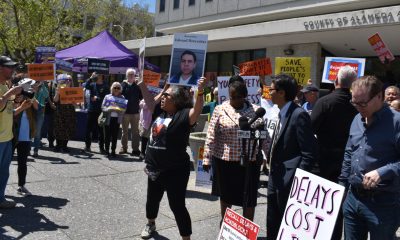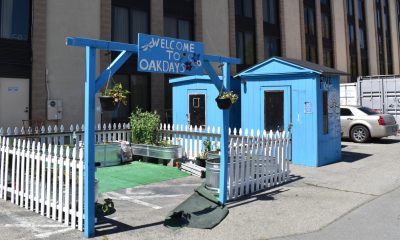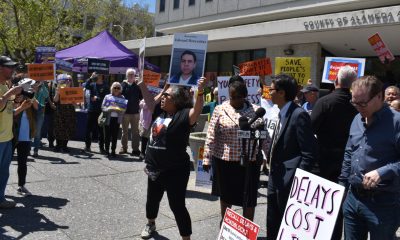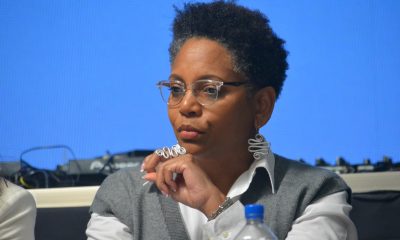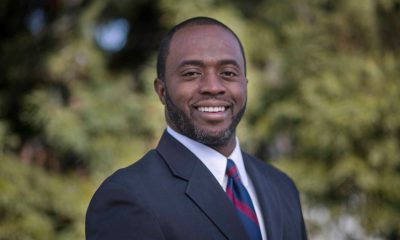Activism
Slashing Greenhouse Gases: California Revises Strategy for Climate Change
“The Air Resources Board’s latest climate plan once again pins California’s future on a dangerous carbon capture pipe dream,” said Jason Pfeifle, a senior climate campaigner at the Center for Biological Diversity. “Caving to polluters who want to keep burning fossil fuels and dirty biomass energy is a one-way ticket to climate destruction. California needs a plan that rejects industry scams, preserves our ecosystems, and rapidly phases out fossil fuels.”

By Nadia Lopez, CalMatters
The California Air Resources Board unveiled a new version of its highly anticipated strategy for battling climate change on Nov. 16, setting more ambitious targets for cutting greenhouse gases and scaling up controversial projects that capture carbon.
If adopted by the air board at its Dec. 15 meeting, the plan would radically reshape California’s economy, alter how Californians’ vehicles, buildings and appliances are powered, and ultimately serve as a blueprint for other states and countries to follow.
“Failure is not an option,” said air board Chair Liane Randolph. “There is too much at stake and we need to move as fast and as far as we can to lessen the worst impacts of climate change and leave future generations a livable and healthy California.”
The five-year climate change strategy, called a scoping plan, outlines in its 297 pages how California could end its reliance on oil and also clean up the nation’s worst air pollution.
The staff’s final draft plan adds bolder commitments, reducing oil use by 94% from 2022 levels by 2045 — up from a goal of 91% in the September version of the plan.
The plan also sets a more aggressive goal of cutting carbon emissions 48% below 1990 levels by 2030 — up from the 40% by 2030 required under state law. Net-zero emissions would be achieved in 2045. (Net-zero or carbon neutrality means striking a balance between the carbon dioxide added to the air and the carbon that’s removed.)
California has a long way to go to meet the new 48% goal in just eight years. By 2020 it had cut emissions only about 14% below 1990 levels, according to air board officials.
Danny Cullenward, a climate economist who serves on a committee advising the state about its system for trading greenhouse gas credits, said California isn’t on track to meet its existing 2030 reduction target, much less the new, more stringent goal.
“I don’t want to say California isn’t doing anything on climate. We’ve done a lot of things,” said Cullenward, who serves on the Independent Emissions Market Advisory Committee. “But this is such a superficial exercise and it’s filled with so many faults and errors.”
Air board officials, however, said they are confident that the state can achieve the new target, largely with mandates and policies enacted this year. State officials phased out sales of new gas-powered cars by 2035, set a more stringent low-carbon fuel standard and streamlined siting and permitting of renewable energy projects.
“This plan is a comprehensive roadmap to achieve a pollution-free future,” Gov. Gavin Newsom said in a statement. “It’s the most ambitious set of climate goals of any jurisdiction in the world, and, if adopted, it’ll spur an economic transformation akin to the industrial revolution.”
But Cullenward criticized the staff’s modeling, which is used to predict how each sector of the economy will reduce emissions. He said the plan lacks a thorough analysis of the feasibility of its projections and makes major assumptions.
One example, he said, is that the plan relies on other agencies, such as the California Energy Commission, setting new policies, but it doesn’t address the timing and roadblocks they may face or other details.
“It’s a pretty aspirational document but it’s filled with bureaucratic doublespeak,” he said. “It’s really frustrating because there’s so much work to be done.”
Some policy experts say setting ambitious goals is a crucial step toward cleaning up air pollution and combating climate change.
“The scoping plan can at least help us direct our attention even if it doesn’t give us as much detail as we want,” said Dave Weiskopf, senior policy advisor with NextGen Policy, a progressive advocacy group. “On the one hand, that is really frustrating. On the other hand, it tells us that if we put in the effort to say what we think a good plan should look like, we at least have a shot of getting the state to take meaningful action.”
The new plan relies more than the original versions on two controversial, advanced technologies for eliminating planet-warming carbon dioxide. Combined, 15% — increased from 5% — of all of the state’s targeted greenhouse gas cuts will come from carbon removal and carbon capture and storage.
One strategy removes carbon from the atmosphere, such as replanting trees or storing it in soils. Another, called carbon capture and storage, collects carbon spewed from industry smokestacks and injects it into the ground.
California currently has no carbon removal or capture and storage projects, and air board officials say they wouldn’t be deployed until 2028. The state’s scenario predicts that carbon-capture technology will be installed on most of California’s 17 oil refineries by 2030 and on all cement, clay, glass, and stone facilities by 2045.
Environmental groups oppose both technologies, saying they extend the lives of fossil fuels, while oil companies say they are necessary to achieve the state’s long-term climate goals. The debate pits those who want to mandate an end to fossil fuels against those who want an approach that relies somewhat on technology to clean up carbon.
Globally, 27 carbon capture and storage projects are operating so far.
Oil industry officials declined to comment on the plan Wednesday.
Achieving the plan’s targets would cost $18 billion in 2035 and $27 billion in 2045, according to air board estimates. The move to decarbonize and transition away from fossil fuels will also drastically increase electricity use, which is expected to soar by as much as 68% in 2045.
At Newsom’s direction, the air board in September already strengthened its draft plan, originally released last May, to include new goals for offshore wind, cleaner aviation fuels and reducing vehicle miles traveled.
Other changes include constructing 3 million climate-friendly homes by 2030 and 7 million by 2035, installing at least 6 million heat pumps by 2030, and eliminating the option of building new natural gas plants or using fossil fuels in the electricity sector to maintain grid reliability.
Eliminating 100 million tons of carbon
Under a new law that Newsom prioritized in his climate package at the end of this year’s legislative session, the air board was directed to create a new program that puts guardrails on carbon capture, use and storage projects while streamlining the permitting process.
These technologies aim to remove or capture and store at least 20 million metric tons of carbon by 2030 and 100 million metric tons by 2045, according to the plan.
Once captured from smokestacks, the carbon could be transported to sites in the Central Valley. Air board staff say the valley is an ideal location for injecting carbon dioxide deep into rock formations because it has the capacity to store at least 17 billion tons.
Though controversial, air board staff say the technologies are a “necessary tool” to reduce emissions from industrial sectors, such as the cement industry, where no other alternatives may exist.
“We’ve squeezed out all of the emissions that we can under the inventory for manufacturing for transportation and for industry, but we know residual emissions will remain,” said Rajinder Sahota, the board’s deputy executive officer for climate change and research. “We’re going to need all the tools in all of these categories.”
But at an Oct. 28 workshop, members of the state’s Environmental Justice Advisory Committee raised several concerns about engineered carbon removal, saying it is an unproven strategy that could continue to plague local communities with air pollution. They also say it would delay closure of oil facilities and act as a substitute for direct emissions reductions.
“The Air Resources Board’s latest climate plan once again pins California’s future on a dangerous carbon capture pipe dream,” said Jason Pfeifle, a senior climate campaigner at the Center for Biological Diversity. “Caving to polluters who want to keep burning fossil fuels and dirty biomass energy is a one-way ticket to climate destruction. California needs a plan that rejects industry scams, preserves our ecosystems, and rapidly phases out fossil fuels.”
Air board staff acknowledged these concerns, but Randolph, the board’s chair, said many of the greenhouse gas targets could not be achieved without them. She said the board has prioritized creating a metric to measure how residents could be affected by these projects and also consider the needs of people who are most affected by air pollution.
Randolph said the plan’s heavy emphasis on cutting emissions from transportation will also significantly improve air quality in vulnerable communities. Cutting vehicle miles traveled and improving access to mass transit, designing more pedestrian-friendly neighborhoods and increasing access to electric bikes and vehicles all play a role.
The board expects the state’s landmark cap and trade program — which allows big polluters to buy credits to offset their greenhouse gas emissions — to play a much smaller role over time.
In the 2017 version of their scoping plan, air board officials estimated about 38% of emissions reductions would come from cap and trade. Instead, it now would help “fill the gap” to meet the accelerated 2030 emissions target.
Cap and trade has been heavily criticized by legislators and experts in recent years. One criticism is that there are at least 310 million unused credits currently in the system, which is a problem because companies hoard credits that allow them to keep polluting past state limits in later years. Air board officials say they hope to reform the program and address the oversupply of credits at the end of next year.
Activism
S.F. Black Leaders Rally to Protest, Discuss ‘Epidemic’ of Racial Slurs Against Black Students in SF Public School System
Parents at the meeting spoke of their children as no longer feeling safe in school because of bullying and discrimination. Parents also said that reported incidents such as racial slurs and intimidation are not dealt with to their satisfaction and feel ignored.

By Carla Thomas
San Francisco’s Third Baptist Church hosted a rally and meeting Sunday to discuss hatred toward African American students of the San Francisco Unified School District (SFUSD).
Rev. Amos C. Brown, president of the San Francisco NAACP and pastor of Third Baptist Church, along with leadership from local civil rights groups, the city’s faith-based community and Black community leadership convened at the church.
“There has been an epidemic of racial slurs and mistreatment of Black children in our public schools in the city,” said Brown. “This will not be tolerated.”
According to civil rights advocate Mattie Scott, students from elementary to high school have reported an extraordinary amount of racial slurs directed at them.
“There is a surge of overt racism in the schools, and our children should not be subjected to this,” said Scott. “Students are in school to learn, develop, and grow, not be hated on,” said Scott. “The parents of the children feel they have not received the support necessary to protect their children.”
Attendees were briefed last Friday in a meeting with SFUSD Superintendent Dr. Matt Wayne.
SFUSD states that their policies protect children and they are not at liberty to publicly discuss the issues to protect the children’s privacy.
Parents at the meeting spoke of their children as no longer feeling safe in school because of bullying and discrimination. Parents also said that reported incidents such as racial slurs and intimidation are not dealt with to their satisfaction and feel ignored.
Some parents said they have removed their students from school while other parents and community leaders called on the removal of the SFUSD superintendent, the firing of certain school principals and the need for more supportive school board members.
Community advocates discussed boycotting the schools and creating Freedom Schools led by Black leaders and educators, reassuring parents that their child’s wellbeing and education are the highest priority and youth are not to be disrupted by racism or policies that don’t support them.
Virginia Marshall, chair of the San Francisco NAACP’s education committee, offered encouragement to the parents and students in attendance while also announcing an upcoming May 14 school board meeting to demand accountability over their mistreatment.
“I’m urging anyone that cares about our students to pack the May 14 school board meeting,” said Marshall.
This resource was supported in whole or in part by funding provided by the State of California, administered by the California State Library via California Black Media as part of the Stop the Hate Program. The program is supported by partnership with California Department of Social Services and the California Commission on Asian and Pacific Islander American Affairs as part of the Stop the Hate program. To report a hate incident or hate crime and get support, go to CA vs Hate.
Activism
Oakland Ambassadors Strengthen Ties and Aid Efforts in Ghana
Oakland natives and esteemed members of the African American Sports and Entertainment Group (AASEG), Jonathan P. Jones and Dr. Maritony Efua Jones, recently embarked on a significant journey to Ghana as guests of the World Martial Authority Ghana. This trip signifies a crucial opportunity to bolster partnerships, explore new avenues of collaboration, and contribute to impactful initiatives in Ghana.
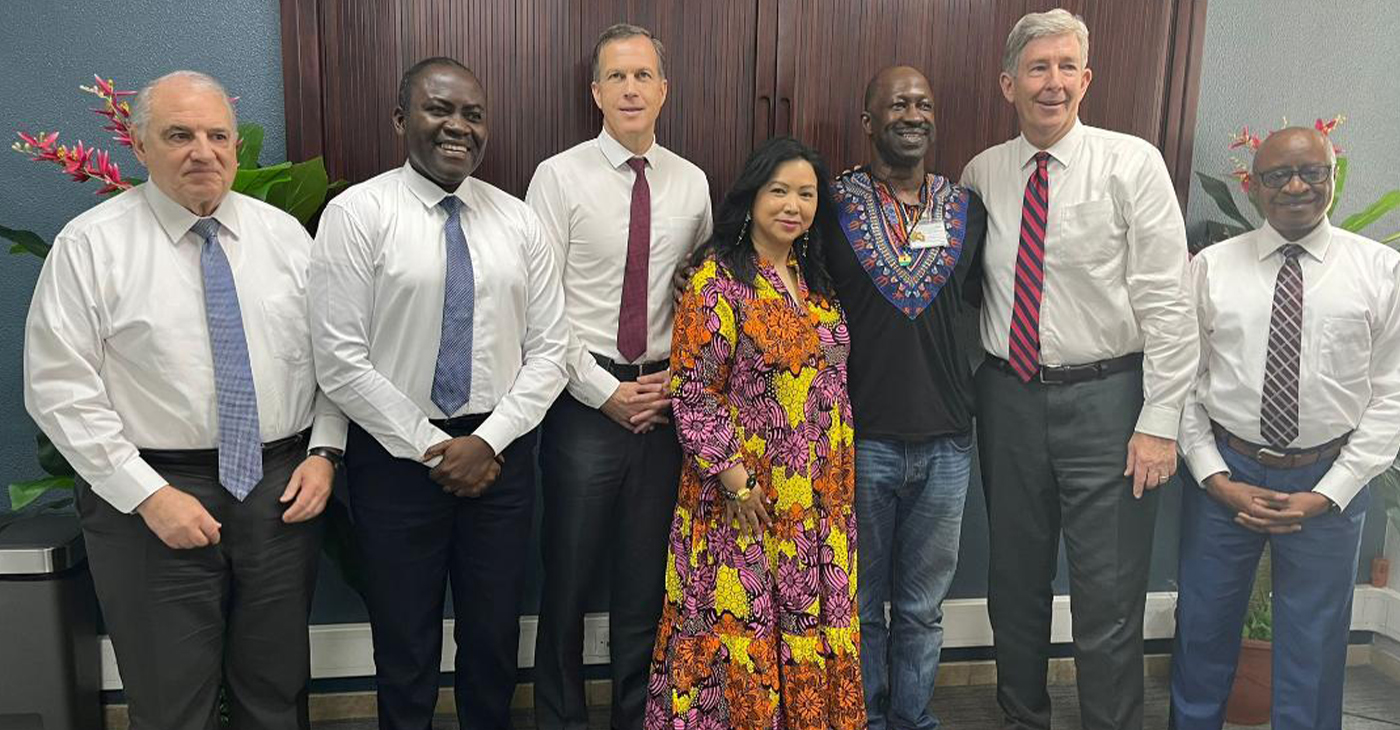
By Post Staff
Oakland natives and esteemed members of the African American Sports and Entertainment Group (AASEG), Jonathan P. Jones and Dr. Maritony Efua Jones, recently embarked on a significant journey to Ghana as guests of the World Martial Authority Ghana.
This trip signifies a crucial opportunity to bolster partnerships, explore new avenues of collaboration, and contribute to impactful initiatives in Ghana.
Upon their arrival at Katota Airport in Accra, Ghana, the Joneses were warmly received by His Royal Majesty Okatakyie Asafo Boakye III, the distinguished king of Sanzule Kingdom in the Eastern Nzema, and Etse Nyamedi of World Martial Authority, Ghana.
Nyamedi accompanied the Joneses to the city of Mepe, which had recently experienced flooding, to assess damages and engage with local leaders, elders, and youth regarding the city’s urgent needs after major floods last fall.
Key concerns and priorities identified by the community include comprehensive flood mitigation measures, agricultural support, housing initiatives, educational enhancements, improved healthcare access, and the development of communal recreational spaces.
The Joneses were also graciously invited to meet with leaders of The Church of Jesus Christ of Latter-day Saints at their headquarters in Accra. This meeting provided insights into ongoing humanitarian efforts in Ghana and explored avenues for collaboration to further assist Ghanaian communities.
The LDS leaders shared their prompt response to the recent flood, demonstrating their commitment to humanitarian aid by dispatching substantial supplies including medical provisions, sanitation items, blankets, and food to assist flood victims just four days after the disaster.
Additionally, Boakye extended a special invitation to the Joneses to his palace, where they were pleasantly surprised with a heartfelt recognition ceremony. Maritony Jones was honored as the Queen Mother of the Sanzule Kingdom in acknowledgment of her dedicated work, while Jonathan Jones was lauded and welcomed as the ambassador of the Sanzule Kingdom, symbolizing a meaningful homecoming to their ancestral land.
The visit not only strengthens ties between Oakland and Ghana but also underscores the collaborative spirit and commitment to meaningful progress and humanitarian endeavors shared by all involved parties.
Activism
Calif. Anti-Sex Trafficking Advocates Discuss Competing Bills, Strategies
Advocates from across California are challenging state officials and community leaders to support legislation that provides resources and services for survivors and victims of human trafficking, as well as assistance as they transition back into civil society. Some of those advocates are also calling for more effective state policy to curtail trafficking, a crime that has an outsized impact on Black children, particularly girls.
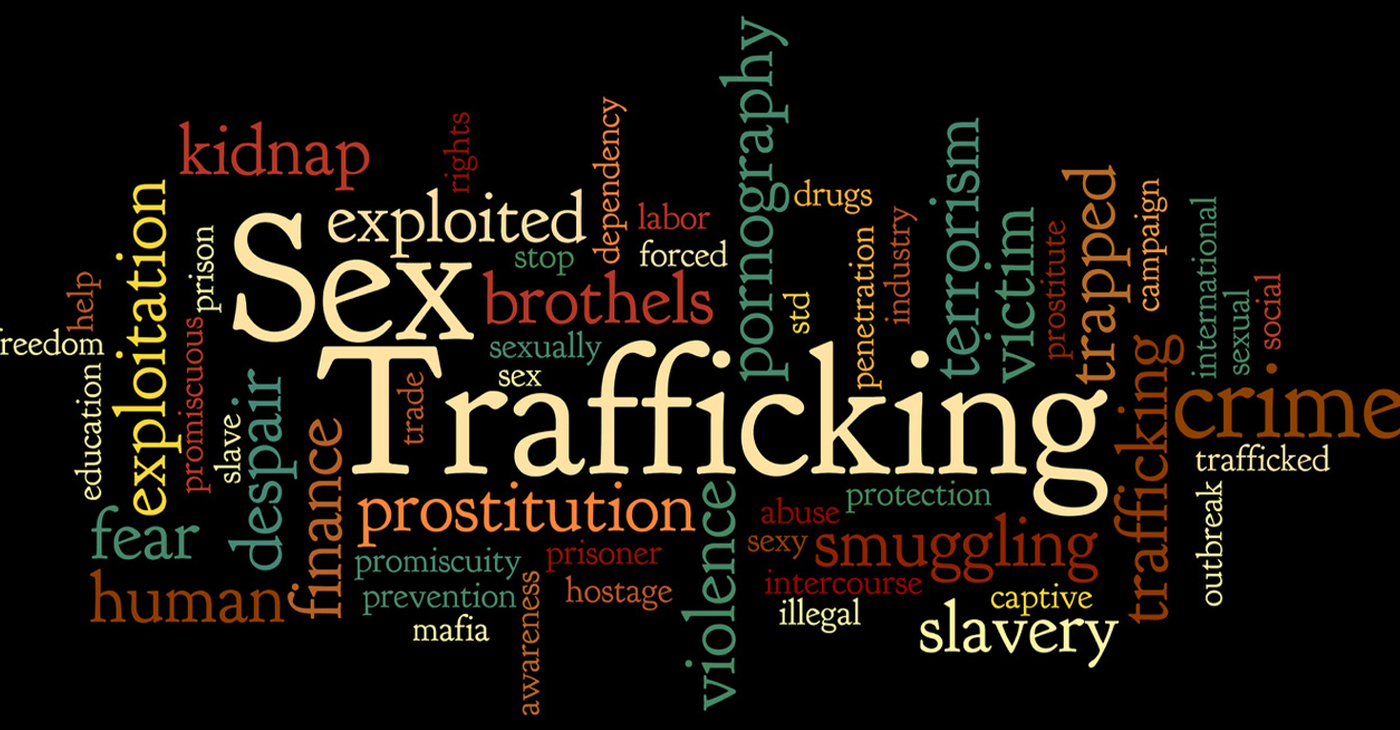
By Bo Tefu, California Black Media
Advocates from across California are challenging state officials and community leaders to support legislation that provides resources and services for survivors and victims of human trafficking, as well as assistance as they transition back into civil society.
Some of those advocates are also calling for more effective state policy to curtail trafficking, a crime that has an outsized impact on Black children, particularly girls.
According to the FBI, a report covering a two-year period found Black children accounted for 57% of all juvenile arrests for prostitution. In addition, 40% of sex trafficking victims were Black and 60% of those victims had been enrolled in the foster care system.
“It is time to hold the perpetrators who take advantage of our children accountable,” said the Rev. Shane Harris, a San Diego-based activist, former foster youth and founder of the Peoples Association of Justice Advocates, (PAJA), a national civil rights organization and policy think tank.
“It is time to send a thorough message that if you seek to buy a child for sex, you will pay the highest criminal penalties in this state,” added Harris who was speaking at a rally at the State Capitol earlier this month. Harris was speaking in support of Senate Bill 1414, authored by Sen. Shannon Grove (D-Bakersfield), which calls for people who buy sex from minors to be punished with a felony. The punishment includes a two-year prison sentence and a $25,000 fine.
Harris said the PAJA is the only civil rights organization in the state that supports SB 1414.
Harris urged other Black-led groups who favor anti-trafficking legislation more focused on criminal justice reforms (as opposed to stiffer penalties), to “join the movement.”
Many of those civil rights groups fear that SB 1414 could lead to the incarceration of more Black youth.
Those sentiments were echoed in a panel discussion organized by Black women advocates on April 26 to examine the cause and effects of human trafficking in California’s Black communities. The virtual event was hosted by the Forgotten Children, Inc, a faith-based nonprofit that advocates for survivors and victims of human trafficking through anti-trafficking campaigns and initiatives.
Panelists shared the psychological impact of sexual exploitation on youth and children in the long term.
Author and educator Dr. Stephany Powell shared statistics and information revealing that African American women and girls are the most trafficked nationwide.
Powell, who serves as the senior advisor on law enforcement and policy at the National Center on Sexual Exploitation said that national data indicates that sex trade survivors are disproportionately women of color. She stated that male survivors often go unnoticed because boys rarely report trafficked crimes.
Powell said that decriminalizing prostitution in California could increase human trafficking. She argued that Senate Bill 357, authored by Sen. Scott Wiener (D-San Francisco), which was signed into law in 2022 and legalized loitering for prostitution, caused a surge in street-level prostitution.
Panelist and psychologist Dr. Gloria Morrow shared opposing views on decriminalizing prostitution. She said that decriminalizing prostitution could help survivors gain access to state resources and support.
Despite opposing views, Powell and Morrow agree that the Black community needs resources and educational programs to address human trafficking.
-

 Community3 weeks ago
Community3 weeks agoFinancial Assistance Bill for Descendants of Enslaved Persons to Help Them Purchase, Own, or Maintain a Home
-

 Activism4 weeks ago
Activism4 weeks agoOakland Post: Week of April 3 – 6, 2024
-

 Business3 weeks ago
Business3 weeks agoV.P. Kamala Harris: Americans With Criminal Records Will Soon Be Eligible for SBA Loans
-

 Activism3 weeks ago
Activism3 weeks agoOakland Post: Week of April 10 – 16, 2024
-

 Community3 weeks ago
Community3 weeks agoAG Bonta Says Oakland School Leaders Should Comply with State Laws to Avoid ‘Disparate Harm’ When Closing or Merging Schools
-

 Community2 weeks ago
Community2 weeks agoOakland WNBA Player to be Inducted Into Hall of Fame
-

 Community2 weeks ago
Community2 weeks agoRichmond Nonprofit Helps Ex-Felons Get Back on Their Feet
-

 Community2 weeks ago
Community2 weeks agoRPAL to Rename Technology Center for Retired Police Captain Arthur Lee Johnson

